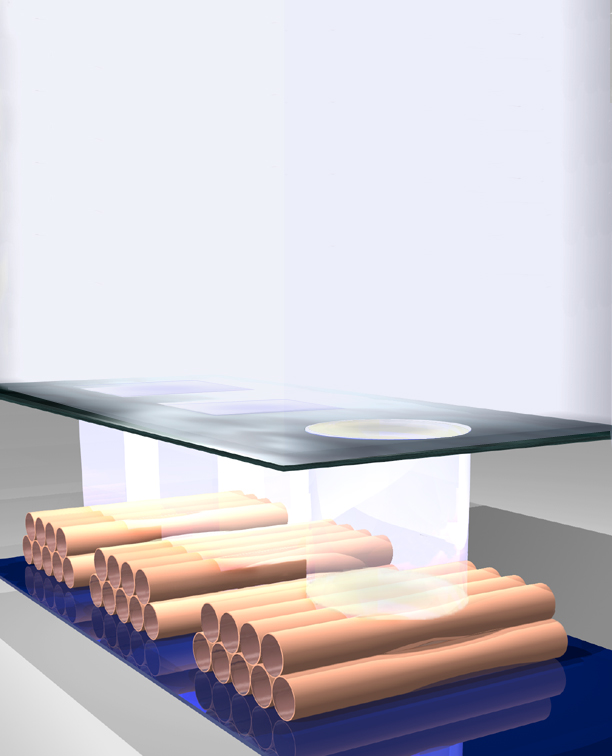
Download 300dpi JPEG image, ‘light.jpg’, 164K (Media are welcome to download/publish this image with related news stories.)
ALBUQUERQUE, N.M. — Pianos and cars may be tuned with wrenches and screwdrivers, but the old clunky tools just won’t do to adjust the sizes of trillions of nanoscopic pores in fine filters, sensors, or diffraction gratings to make them work better.
Now, in the Oct. 6 issue of the journal Science, an Albuquerque-based research group reports precise size adjustments of nanopores through use of a simple ultraviolet beam of light.
The precision is so great that it could achieve the long-sought goal of membrane-based separation of oxygen from nitrogen, a difference in size of 0.2 Angstroms [0.02 nanometers], says Jeff Brinker, senior scientist at the Department of Energy’s Sandia National Laboratories, professor at the University of New Mexico, and lead researcher on the multi-institution project.
A joint patent application has been filed on the process by Sandia and UNM.
“The Holy Grail of membrane science is air separation,” says Brinker. “People would love a filter that could separate oxygen from nitrogen. Industrialists have invested hundreds of millions of dollars to do that. Now, in a systematic way, we might go from pores of, say, 3.4 to 3.6 angstroms in diameter, tuning the membrane to optimize oxygen-nitrogen separation.”
The work is an extension of a four-paper series published by Brinker’s group in the journal Nature, detailing the group’s inquiries into the properties of nanostructures that self-assemble to produce repeating patterns of pores of exactly the same size.
In this case, the honeycomb-like structure, which might be visualized as a group of soda straws lying together in a bundle, have pores that shrink in unison when illuminated by a beam of light.
“Using light to change pore size is a kind of nanostructural engineering,” Brinker says. “In addition to creating an overall pattern as achieved by conventional lithography, this kind of lithography also can help us define the internal structure of the films on the nanoscale. Even though the overall shapes we create are at the high end of the nanostructure regime, the light influences pore size and connectivity in the heart of nanoland, varying pore sizes continuously over a range within that illuminated pattern.”
Creating tunable zeolites
In effect, he says, the process creates a kind of tunable zeolite, thereby enhancing the capability of membranes to separate molecules by size. This is done merely by exposing the membrane — in this case, self-assembled thin-film silica that is photosensitive — to the proper amount of light. “Tuning a ten-angstrom hole to 8 or 9 angstroms should make a huge difference in membrane performance,” says Brinker.
Key to the pore size changes are photoacid molecules that self-assemble and uniformly incorporate into a periodic nanostructure. A light shone on these molecules breaks them apart to form an acid that causes silica to solidify locally. The amount of solidification, which necessarily shrinks pore sizes to create the denser material, is proportional to the amount of light shone on the membrane.
Zeolites are crystalline structures with tiny but unalterable pore sizes widely used by industry to separate materials. As filters they are precise, but their pore sizes are unchangeable.
In the paper’s introduction, the authors write, “The ability to optically define and continuously control both structure and function on the macro- and mesoscales is of interest for sensor arrays, nanoreactors, photonic and fluidic devices, and low-dielectric-constant films.”
A further feature involves shining light through a lithographic mask that varies its intensity, producing so-called “gray-scale” patterning, which theoretically allows for a broad continuous spatial variation of the materials’ structure and properties.
The same process also can be used to produce optical diffraction gratings — devices that can redirect and filter light — made entirely of laser-damage-resistant silica.
Dhaval Doshi (a UNM graduate student), Kelly Simmons-Potter, and B.G. Potter, both at Sandia, used an evaporation-induced, self-assembly process to prepare and characterize photosensitive films. The work incorporated molecular photoacid generators compartmentalized within a silica-surfactant mesophase.
“While modifying pore sizes by small amounts so far seems to be completely controllable, we haven’t yet demonstrated control in going from huge to teeny pores,” says Brinker. “We’re not sure what the dynamic range of the process is.”
Other researchers on this project include Alan Hurd from Sandia and researchers from the Vienna University of Technology and Applied Materials Corp. in Santa Clara, Calif.
The work is funded by DOE’s Office of Basic Energy Sciences, the Defense Advanced Research Projects Agency (DARPA), and Sandia’s Laboratory-Directed Research and Development (LDRD) program.